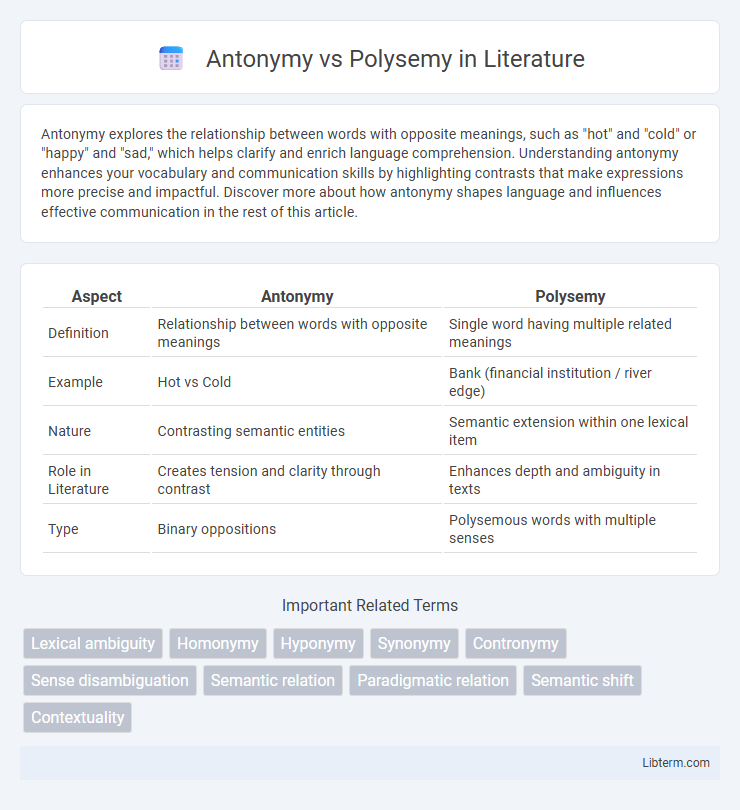Antonymy explores the relationship between words with opposite meanings, such as "hot" and "cold" or "happy" and "sad," which helps clarify and enrich language comprehension. Understanding antonymy enhances your vocabulary and communication skills by highlighting contrasts that make expressions more precise and impactful. Discover more about how antonymy shapes language and influences effective communication in the rest of this article.
Table of Comparison
| Aspect | Antonymy | Polysemy |
|---|---|---|
| Definition | Relationship between words with opposite meanings | Single word having multiple related meanings |
| Example | Hot vs Cold | Bank (financial institution / river edge) |
| Nature | Contrasting semantic entities | Semantic extension within one lexical item |
| Role in Literature | Creates tension and clarity through contrast | Enhances depth and ambiguity in texts |
| Type | Binary oppositions | Polysemous words with multiple senses |
Understanding Antonymy: Definition and Types
Antonymy involves words with opposite or contrasting meanings, fundamentally categorized into gradable, complementary, and relational antonyms. Gradable antonyms represent opposite ends of a spectrum, such as "hot" and "cold," allowing for intermediate states. Complementary antonyms, like "alive" and "dead," show binary opposition without middle ground, while relational antonyms, for example "teacher" and "student," indicate reciprocal relationships.
Exploring Polysemy: Meaning and Examples
Polysemy occurs when a single word possesses multiple related meanings, enriching language complexity and communication. For instance, the word "bank" can denote a financial institution or the side of a river, illustrating semantic flexibility. This linguistic phenomenon contrasts with antonymy, where words hold opposite meanings, highlighting semantic diversity within natural language.
Key Differences Between Antonymy and Polysemy
Antonymy involves words with opposite meanings, such as "hot" and "cold," highlighting a clear contrast in semantics. Polysemy occurs when a single word possesses multiple related meanings, like "bank" referring to a financial institution or the side of a river. Key differences include antonymy's reliance on binary opposition between distinct word meanings, whereas polysemy centers on one word encompassing various connected senses within a semantic network.
Linguistic Significance of Antonyms
Antonyms play a crucial role in linguistic semantics by providing clear contrasts that help define meanings and enhance language precision. They facilitate cognitive processing by enabling speakers to categorize concepts through opposition, which supports effective communication and comprehension. The study of antonymy also aids in understanding lexical relationships and semantic fields, enriching language learning and natural language processing applications.
Polysemy in Everyday Language
Polysemy occurs when a single word has multiple related meanings, which is common in everyday language and enriches communication by allowing speakers to convey nuanced ideas efficiently. Words like "bank" can refer to a financial institution or the side of a river, demonstrating how context guides interpretation. Understanding polysemy enhances language comprehension and helps avoid ambiguity in conversations and written texts.
Cognitive Processes Underlying Antonymy
Antonymy involves cognitive processes that recognize and categorize opposite meanings by contrasting semantic features within mental lexicons, enabling efficient language comprehension and communication. The brain utilizes semantic networks to map antonym pairs based on binary oppositions such as hot-cold or big-small, facilitating quick retrieval and differentiation. These processes support conceptual oppositions fundamental to semantic memory and linguistic prediction during speech.
Semantic Ambiguity: Challenges with Polysemy
Polysemy presents significant challenges in semantic ambiguity due to a single word having multiple related meanings, which can complicate natural language processing and interpretation. Antonymy, by contrast, involves words with opposite meanings, offering clearer semantic boundaries but still posing difficulties in nuanced contexts. Disambiguating polysemous words requires advanced semantic analysis and contextual understanding to accurately capture intended meanings across various usages.
Role of Antonymy and Polysemy in Communication
Antonymy enhances communication by providing clear contrasts that help distinguish meanings and clarify intentions, which is essential for effective vocabulary use and language comprehension. Polysemy enriches communication through multiple related meanings of a single word, allowing for nuanced expression and deeper contextual understanding. Both play pivotal roles in language processing: antonymy simplifies decision-making by highlighting differences, while polysemy supports flexibility and creativity in conveying complex ideas.
Applications in Language Learning and NLP
Antonymy, the relationship between words with opposite meanings, and polysemy, where a single word has multiple related meanings, play crucial roles in language learning and natural language processing (NLP). Antonymy aids vocabulary acquisition by clarifying semantic boundaries and enhancing contrastive understanding, while polysemy challenges word sense disambiguation algorithms in NLP, requiring advanced contextual analysis for accurate interpretation. Leveraging antonymy and polysemy frameworks improves machine translation, sentiment analysis, and semantic search by refining lexical semantic networks and enabling more nuanced language comprehension.
Comparing Antonymy and Polysemy: Conclusions and Implications
Antonymy involves words with opposite meanings, such as "hot" and "cold," while polysemy refers to a single word having multiple related meanings, like "bank" meaning both a financial institution and the side of a river. Comparing antonymy and polysemy reveals differences in semantic relationships; antonymy focuses on contrasting meanings, whereas polysemy highlights semantic extension and flexibility. Understanding these distinctions has implications for linguistics, lexicography, natural language processing, and semantic analysis, improving word sense disambiguation and enhancing language comprehension algorithms.
Antonymy Infographic

 libterm.com
libterm.com